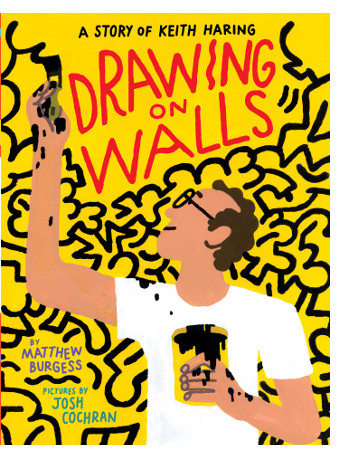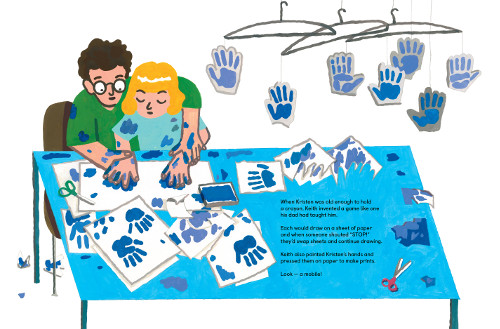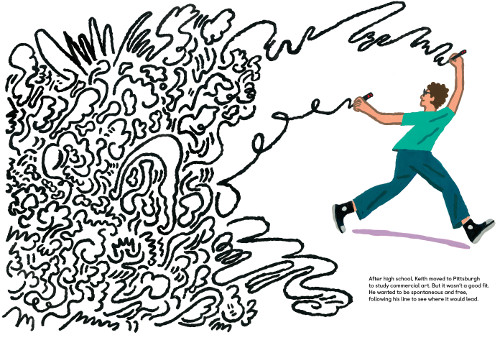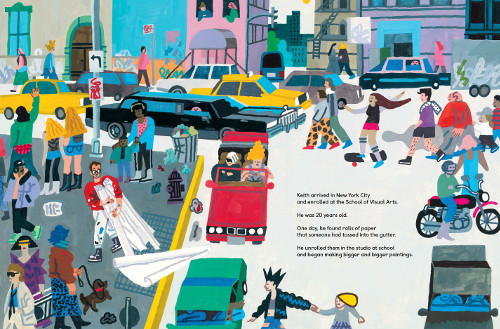Drawing on Walls Before Breakfast
 July 14th, 2020 by jules
July 14th, 2020 by jules
(Click spread to enlarge)
Note that today’s book, as the subtitle tells us, is “a” story of legendary artist Keith Haring. It’s not “the” story of Keith Haring, because it’s not as if only one story could capture his life and his spirit. This subtle word choice is one of many thoughtful details that went into the creation of this spectacular picture book biography.
Drawing on Walls: A Story of Keith Haring (Enchanted Lion, May 2020), written by Matthew Burgess and illustrated by Josh Cochran, opens with the spread pictured above, which so perfectly communicates the essence of Keith’s artistic vision—and legacy. At this page turn, we then meet Keith as a child. …
 Keith, we read, drew frequently with his father, his mother reminding him, “just as he was getting some big ideas,” not to draw on the walls. He delighted in being a brother to three younger sisters and often played with them. At school, Keith continued making art and discovered that he loved drawing “anything with a twisting, turning line … that traveled through and around, up and down, in and out again.” In essence, he discovered his style here, at this young age.
Keith, we read, drew frequently with his father, his mother reminding him, “just as he was getting some big ideas,” not to draw on the walls. He delighted in being a brother to three younger sisters and often played with them. At school, Keith continued making art and discovered that he loved drawing “anything with a twisting, turning line … that traveled through and around, up and down, in and out again.” In essence, he discovered his style here, at this young age.
After high school, Keith moved from a small town in Pennsylvania to Pittsburgh to study commercial art but quit and made his way to New York City, eventually enrolling at the School of Visual Arts (where the book’s illustrator now teaches). He spent a great deal of time making large paintings and doing so near places where people passed. As quoted in the book, he believed the public “has a right to art. … Art is for everybody.” In New York City, he also fell in love with Juan DuBose, a deejay, and worked with children, teaching them drawing at a daycare center in Brooklyn.
The book notes Keith’s major influences—the writings of artist Robert Henri, as well as the art of Pierre Alechinsky; travel; the library, where he read about artists he admired; the East Village in Manhattan; the graffiti of Alphabet City (also in Manhattan); the Paradise Garage and it’s “thump and beat of music”; and more. The latter part of the book chronicles his rise to fame but notes that …
… no matter how busy he became or where in the world he went, he always made time for children. Keith understood kids and they understood him. There was an unspoken bond between them.
There are a lot of things to love about this biography, including how succinctly, reverently, and lovingly the author nails what made Keith special. (On the spread where we read that Keith learned he had AIDS, we read a quote about how he believed he had a “silent bond” with children and that children can “sense this ‘thing’ in me.”) Best of all, it doesn’t shy from the fact that Keith was gay. The text also states matter-of-factly that he had AIDS. These aren’t things mentioned merely in the back matter; they are a part of Keith’s story. This is a book that embraces all of Keith—not just select parts of him. It’s a book that trusts that child readers can handle the truth. Please, more picture book biographies like this.
Also, there couldn’t have possibly been a better choice for illustrator. Josh Cochran captures Haring’s style (and genius) without being over-the-top imitative. It’s art that bursts with color and movement. The book is a splendid symbiosis of text and art.
There are also detailed design decisions that serve this book well, including the book’s tall trim size (perhaps to match Haring’s larger-than-life, big, outdoor style). The book’s cover, with its eye-popping, vivid yellow-orange shade, is even slightly padded. It’s not as puffy as, say, those very padded board books for children, but it’s slightly so; it’s soft to the touch, fitting for the modern, pop-art style of Haring’s work. I love that the cover also notes “Pictures by Josh Cochran.” That is, it’s not “illustrated by ….” Something about that more colloquial, less formal wording is fitting for Keith, who believed art should be for everyone.
But my favorite detail? On the final page, after we read that Keith left this world at the young age of 31, we revisit Keith as a child, drawing with his father. Keith is drawing lines on a paper, but his thick black line expands beyond the boundary of the paper. He’s quite literally drawing on the table itself. Because, as the author notes, “Keith’s line is still with us … and it goes on forever.”
Here are some more spreads from the book. …

Keith invented a game like one his dad had taught him. …”
(Click spread to enlarge and read text in its entirety)

But it wasn’t a good fit. He wanted to be spontaneous and free,
following his line to see where it would lead.”
(Click spread to enlarge)

the School of Visual Arts. He was 20 years old. …”
(Click spread to enlarge and read text in its entirety)

(Click spread to enlarge)
DRAWING ON WALLS: A STORY OF KEITH HARING. Text Copyright © 2020 by Matthew Burgess. Illustration Copyright © 2020 by Josh Cochran. Illustrations reproduced by permission of the publisher, Enchanted Lion Books, Brooklyn, New York.

